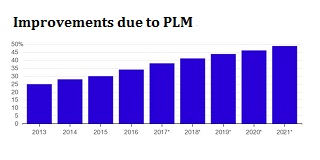|
PLM Interest Group |
|||||||||||||||||||||||
|
|
|
|
|||||||||||||||||||||
|
|
|
|||||||||||||||||||||
|
|
|
|
|||||||||||||||||||||
|
Business Transformation
'Good Enough' - is not Good Enough Everyone knows that the PLM Team has to provide hard financial figures that show a good NPV or IRR before new projects get the go-ahead, and this means going through a formal GAP and impact analysis. It also means that the "unquantifiable" benefits of PLM need to be quantified. So there may be a temptation to reach straight for the PLM Justification Handbook and call up the PLM Metrics Algorithm. But it's too soon to do that. All you would be doing would be to generate numbers that quantify a sub-optimal environment. In order to reach the full potential of PLM, you have to aim high.
Step 1: Belief In financial terms, this means going beyond the usual mundane goal of "producing a cost justification that the Board will sign off". It means starting from the viewpoint that: "We should implement PLM because it is going to make the company an enormous amount of money. Millions. Everyone in the organisation will be financially better off because of what PLM is doing for the business."
If you look at your own PLM implementation, where would you honestly say you are:-
If you do not believe that PLM will be of huge financial benefit to your company, then you will never get the figures to prove it.
Step 2: Facing the Truth Once you have that belief, the next thing to do (before doing the sums) is to face the truth about the shortcomings of your current PLM and of your company's real operating environment, and to make these work for you. If you ignore the weak points, and raise a proposal for funding that hides them, then they become pitfalls that will derail the project and cause it to fail. But if you analyse them, and provide written evidence of them, then they become "war stories" that will reinforce the need for improvement. In fact it is well worth investigating as many factual examples of inefficiency and quality failures as possible. You should then go on to produce a Gap and Impact Analysis that is endorsed by the people in your organisation most affected by the problems. The PLM Self-Assessment Toolkit is a very useful tool for this. Internal political constraints may mean that you will not be able to use some of these stories, but if your collection is large enough then the remainder will provide the ammunition you need. Once you have that in place, the next thing to do is to do the maths.
Step 3: Doing the Maths Calculating accurately the benefits that will accrue from PLM transformation requires mathematics. It is not guesswork, and it is not an act of faith. The way to calculate the financial benefits of your future PLM programme is to apply the same mathematical rigour as you would to, say, solving simultaneous equations. Firstly, as with simultaneous equations, you express everything in terms of one variable - PLM Benefits. Not "PLM Value", or "Features", or "Points of Pain", but Benefits. There is an Analysis Algorithm that shows you how to do this. These single variables are passed through the PLM Metrics Algorithm, which deconstructs each one into its component elements in a way similar to finding highest common factors in algebra. Except that in this case, the tools are PLM-related, including the '16 Axes of PLM', the '6 Elements of Metrics', and the '5 Whats' questioning sequence. The rest comes down to determination (because doing the calculations requires effort); and discipline (to keep following the methodology). The whole approach is set out in the PLM Justification Handbook and explained in more detail on the elsewhere on this site.
Step 4: Talking Finance PLM managers want their Finance Director to learn about PLM, because as soon as he understands it, the FD will naturally want to endorse all of the important PLM improvements that the company needs. But how much time do PLM Managers spend understanding the work of the Finance Director? If the PLM Team's aim is to establish the financial benefits of PLM, will a particular improvement appear in the Profit & Loss Account or the Balance Sheet? Do the company accounts break down in a way that will make the improvement visible, or will the accountants have to do extensive manual calculations to monitor it? The PLM Manager will need the help and active support of his or her Finance Department colleagues in order to show how the transformational PLM improvements will appear in the real company accounts. To get that help, he or she needs to be able to talk their language. If you find accountancy a "grey area", the Accountancy Overview for PLM Managers explains clearly and simply how even the most complex corporate accounts are generated, in a way that the layman can easily understand. With a minumum of effort, PLM practitioners can learn enough to debate with their Finance Department colleagues on equal terms. When you can talk to them on this level, and involve them in the process of quantifying the financial effects of the PLM benefits, they take on ownership of the figures and are motivated to support them. For the first time, your Finance Department colleagues will no longer be "obstacles to be persuaded", but will be on board and fighting your case. Which is in itself transformational. © Copyright 2025 PLM Interest Group |
||||||||||||||||||||||
| <<< Return Home | |||||||||||||||||||||||
|
|
|
|
|||||||||||||||||||||





